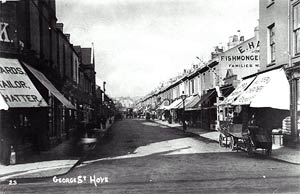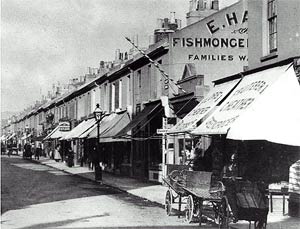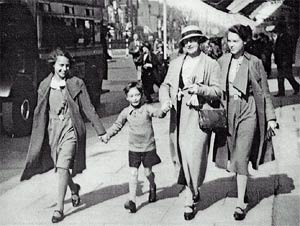I was born on the 12th March 1930 at 51 Portland Villas, Hove, East Sussex, wrote Phil Hayden, whose father had two shops in the town: a fishmongers and poulterers; and a furnishing and carpeting store. No.1 George Street was a wet fish and poultry shop, which had been started by my Grandfather in the middle 1880s. The other shop was 'Fryers' furniture and carpets in New Church Road. My two sisters, Betty and Doris were then (in 1930) nine and seven years of age and would have been attending junior school. My earliest memories of living at Portland Villas are of being pushed in a pram by my sisters, perhaps on a Sunday afternoon, along Portland Road to Portslade Station, across the level crossing and on up Boundary Road. Across Old Shoreham Road and on up Hangleton Road, their goal being to get as far as the old mill at West Blatchington. I recall that on the north-east corner of the junction at Old Shoreham Road there was an old chalk pit which over the years had been used as an unofficial rubbish tip and was full of old bikes, prams, mattresses and other old junk. It was a real eyesore but a place of endless fascination to a small child. | 
George Street, Hove c 1905 looking north.
| The houses at the lower end of Hangleton Road would have been built about the middle to end of the 1920s and into the early 1930s. Those on the eastern side stretched northward only about as far as Martin Road, beyond that it was largely undeveloped right up to West Blatchington where the mill stood more or less alone with St. Peter's Church. The Grenadier Hotel was built in the middle 1930s, as was the housing around Nevill Avenue to the east and the roads to the north-west of what is now Queen's Parade. In those days one could have walked from there over the fields to Devil's Dyke, perhaps some three miles distant, or up to what is now King George VI Avenue to the top of Red Hill, down Waterhall Hill (Mill Road) passing the mill which stood at the bottom of Coney Hill to the junction of Mill Road and the Brighton-London Road at Patcham Manor, having passed through the single arch bridge which carried the main Brighton-London railway line over Mill Road. If you were a really keen rambler (and rambling was a national pass-time then) you could have carried on up over Scare Hill, where there is an ancient tumulus to the Indian War Memorial or Chatri - I remember doing it once with my parents when I was about six. It must have been quite a slog for a child. Another vivid memory of living at Portland Villas was of our next door neighbour. Ernie Russell was a private-hire chauffeur, and owned a magnificent Rolls-Royce car. Finished in buff with black mudguards and with bright steel 'Easyclean' wheel discs. I guess Ernie's business was to chauffeur some of the well-to-do residents of Hove about, people who were not well off enough to maintain a full time chauffeur and a car themselves. Ernie wore a smart uniform with a jacket which buttoned up down the right hand side, fawn jodhpur riding breeches and shiny black leather knee gaiters, and of course a cap. I wonder what became of that car? But even of more interest to me as a little boy was Ernie's garden railway layout, a gauge one electric three-rail track with stations, bridges, tunnels, level crossings, points and signals with lots of locos and rolling stock. Some of the locos were even live steam and that lovely smell of the mixture of methylated spirit, oil and steam still conjures up memories of watching Ernie 'playing trains'. There was also at that time a little 12 inch gauge railway running along the grass of the Esplanade which lay to the West of Hove Street, a replica of the Southern Railway's 'Lord Nelson'. I had many a ride on that and loved watching the driver put coal on the fire with a tiny shovel. | 
No.1 George Street, Hove - F Hayden & Son, fishmonger and poulterer.
| When I was about five, the family removed to 36 Pembroke Crescent which was a larger house. My father had a big Morris Isis car, built in Oxford from American-made Budd body panels, it was finished in maroon (wine) with black mudguards and looked like the sort of car that one saw in American movies about gangland Chicago. Our next door neighbours were a couple who I guess one could say that they had 'arrived'! He was a house agent and was either the then Mayor of Hove, or had been - she was a very smart Jewish lady who having no children of her own perhaps made a bit of a fuss of me and I thoroughly enjoyed being cuddled by her; she wore heady perfume and would press my face into her ample bosom - I think it was then that I fell in love for the first time! They had what I suppose must have been one of the first imported American cars in Hove, a Chrysler Airflow saloon which with its pale ice-blue metallic finish looked something quite special, especially when standing next to my dad's car. Now, when I see photos of the Chrysler with its American Art Deco styling (ugh!) it strikes me as ugly and kitsch. About this time I started at school, firstly a little kindergarten, St. Catherine's, which I think was in Medina or Albany villas, and then later on I went to Hove High School on the corner of Blatchington Road and Sackville Road run by a Miss Hoyle and her brother, my maroon and gold blazer having been bought at Archie Mayler's school outfitters in George Street. My auntie Lou (Louise) had bought me a little pen and pencil set of which I was very proud - how disappointed I was to find out that one wore them inside one's top pocket with just the clips showing, I thought it should be the other way about - what was the point of having a nice pen and pencil if you didn't flaunt them! My dad's fish and poultry shop was at the Church Road end of George Street, next door to Shaw's very modern grocery store which occupied about four shops on the corner of George Street. Broadley's the outfitters were on the opposite corner and Bland's cooked meat shop practically opposite. Further up George Street, on the east side, was Brown's hardware store run by Mr & Mrs Sid March who were great friends of my parents. Further up still there was Thompson's the jewellers (another former Hove Mayor) and a couple more fish shops (Blackman's and Coe's). George Street was then a very busy shopping street with two-way traffic in it. Dad had several men and boys working in his shop - Mr. Sid Wingate was his 'first man'. There was no fridge, only a long ice box along one wall of the shop. Blocks of ice were delivered daily by a man with a horse and cart from Carlo Gatti's ice works; he would carry big blocks of ice into the shop on his back, holding them with a big pair of tongs they were put in the icebox and broken up with an ice pick by the shop 'boy'. | 
Church Road, Hove looking west towards the Sackville Road traffic lights c 1936.
Young Phil Hayden holding hands with his mother Ann (wearing hat) and his sister Doris. On the right is his elder sister Betty.
| Fish displayed on the shop front had only running water trickling over them and the whole front of the shop was open to this busy road. Much of the poultry and game were hung unplucked outside, framing the shop front. Deliveries were made by bicycle, a couple of lads being employed for that purpose. Other shops in the vicinity that I can remember were Streets the jeweller, Prides (optician) and further along New Church Road there was Forfar's bakery and cafe, Denches toyshop, Parris & Greening the chemist and on the South side, Applegate's the hairdresser where I had my first real haircut, and Dowsett's the butcher. About 1937, the family moved from Pembroke Crescent to a smaller house in Goldstone Crescent (No. 26, one of Cook's houses) at the western end of the road - some of the last houses built in Hove before World War 11. At the same time, I started going to Ellen Street School, and now when I think that I must have walked to and from Ellen Street to Goldstone Crescent four times a day - there were no school dinners then, I find it hard to imagine, it was a distance of about a mile and only if it was wet could I get the number 13 bus. I loved it at Goldstone Crescent, the garden backed on to land occupied by the Water Company and contained the big cooling pond for the water from the boilers in the pumping station, now part of the Engineerium, and the allotments. My two school chums, Gordon & Bobby Wainwright, had the run of this land as their father was one of the engineers at the waterworks - the Wainwrights lived in one of the four waterworks' cottages which lay within that rectangular piece of land bounded to the east by Woodland Drive and to the west by the houses on the east side of Nevill Way. It was about 70 yards wide and lay in that now developed area between Nevill Road and Chartfield Way, and it was a wonderful place for growing boys to play. Another memory that I have of Ellen Street School was the cupboard full of plimsolls which had to be used in the school buildings by children who had no shoes of their own, and there were a number like that - that was real poverty, not like today when one is regarded as disadvantaged if they haven't got a TV or own a mobile phone!
| 

